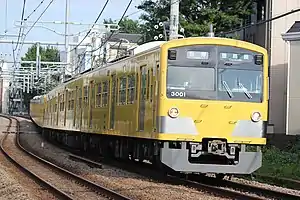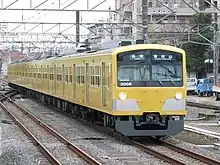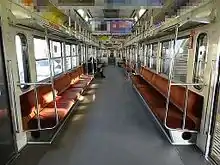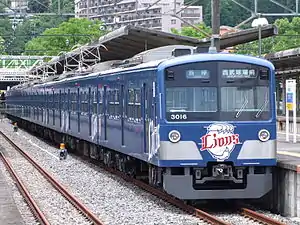Seibu 3000 series
The Seibu 3000 series (西武3000系) was an electric multiple unit (EMU) train type operated by the private railway operator Seibu Railway on commuter services in the Tokyo area of Japan from 1982 until 2014.[1]
| Seibu 3000 series | |
|---|---|
 Set 3001 in July 2012 | |
| In service | 1982 - 2014 |
| Manufacturer | Seibu Tokorozawa Railway Works, Tokyu Car Corporation |
| Constructed | 1982-1987 |
| Scrapped | 2010- |
| Number built | 72 vehicles (9 sets) |
| Number in service | None |
| Formation | 6/8 cars per trainset |
| Fleet numbers | 3001-3017 |
| Operator(s) | Seibu Railway |
| Depot(s) | Kotesashi, Minami-Iriso |
| Line(s) served | Seibu Ikebukuro Line, Seibu Shinjuku Line |
| Specifications | |
| Car body construction | Steel |
| Car length | 20 m (65 ft 7 in) |
| Doors | 3 pairs per side |
| Maximum speed | 105 km/h (65.2 mph) |
| Traction system | Resistor control Field chopper control |
| Electric system(s) | 1,500 V DC |
| Current collector(s) | overhead catenary |
| Multiple working | N/A |
| Track gauge | 1,067 mm (3 ft 6 in) |
Design
Nine 8-car sets (72 vehicles) were built between 1982 and 1987, intended for use on all-stations "Local" services on the Seibu Ikebukuro Line.[1] The trains combined 20 m long steel bodies with three pairs of sliding doors per side, based on the New 101 series design with similar underframes as the 2000 series trains.[1] The trains were originally painted in the same livery applied to the 101 and 301 series trains, consisting of "lemon yellow" with a "warm grey" band around the windows, and unpainted stainless steel doors, but by 1999, the fleet was repainted in all-over yellow.[1] The trains were air-conditioned from new.[1]
Fleet
By 2014, the fleet consisted of two 8-car sets, based at Kotesashi and Minami-Iriso depots for use on Seibu Ikebukuro Line and Seibu Shinjuku Line workings respectively, and two 6-car sets based at Minami-Iriso.[2] These sets were withdrawn from service by December 2014.[3]
Formations
8-car sets
The eight-car sets were formed as shown below with six motored ("M") cars and two non-powered trailer ("T") cars.[2]
| Car No. | 1 | 2 | 3 | 4 | 5 | 6 | 7 | 8 |
|---|---|---|---|---|---|---|---|---|
| Designation | Tc1 | M1 | M2 | M3 | M4 | M5 | M6 | Tc2 |
| Numbering | 3000 | 3100 | 3000 | |||||
- Cars 2, 4, and 6 were each equipped with two lozenge-type pantographs.[2]
- Car 2 was designated as a mildly air-conditioned car.[2]
6-car sets

The six-car sets were formed as shown below with four motored ("M") cars and two non-powered trailer ("T") cars.[2]
| Car No. | 1 | 2 | 3 | 4 | 5 | 6 |
|---|---|---|---|---|---|---|
| Designation | Tc1 | M1 | M2 | M5 | M6 | Tc2 |
| Numbering | 3000 | 3100 | 3000 | |||
Interior

Seating consisted of longitudinal bench seating throughout. Priority seats were provided at the end of each car.[2]
History
In 2010, sets 3005 and 3007 were reduced from eight to six cars, and the surplus cars scrapped.[4] In December 2014, set 3009 was also reduced from eight to six cars.[5]
The last two remaining sets, eight-car sets 3009 and 3011, were withdrawn from service in December 2014.[3]
Livery variations
Ikebukuro Line set 3011 was repainted in a Galaxy Express 999 livery from May 2009, and set 3015 was repainted in a Saitama Seibu Lions baseball team livery from July 2010 and branded "L-train".[1]
 KuHa 3011 (Ikebukuro end) of set 3011 in Galaxy Express 999 livery, October 2010
KuHa 3011 (Ikebukuro end) of set 3011 in Galaxy Express 999 livery, October 2010 KuHa 3012 (Hanno end) of set 3011 in Galaxy Express 999 livery, May 2009
KuHa 3012 (Hanno end) of set 3011 in Galaxy Express 999 livery, May 2009 Set 3015 in Saitama Seibu Lions livery, July 2010
Set 3015 in Saitama Seibu Lions livery, July 2010
Resale
Six-car set 3007 and six cars of former eight-car set 3009 were transferred to the Ohmi Railway in Shiga Prefecture following their withdrawal in November and December 2014, respectively.[3]
References
- 私鉄車両年鑑 2013: 大手15社営業用車両完全網羅 私鉄車両年鑑2013 [Japan Private Railways Annual 2013]. Tokyo, Japan: Ikaros Publications Ltd. 20 March 2013. p. 200. ISBN 978-4-86320-693-9.
- 私鉄車両編成表 2014 [Private Railway Rolling Stock Formations - 2014]. Japan: Kotsu Shimbunsha. 24 July 2014. pp. 54–59. ISBN 978-4-330-48414-3.
- 私鉄車両編成表 私鉄車両編成表 2015 [Private Railway Rolling Stock Formations - 2015] (in Japanese). Japan: Kotsu Shimbunsha. 23 July 2015. p. 198. ISBN 978-4-330-58415-7.
- 私鉄車両編成表 私鉄車両編成表 2011 [Private Railway Rolling Stock Formations - 2011]. Japan: Kotsu Shimbunsha. July 2011. p. 186. ISBN 978-4-330-22711-5.
- 3000系3009編成が6輌化されて小手指車両基地へ [3000 series set 3009 reduced to 6 cars and transferred to Kotesashi Depot]. RM News (in Japanese). Japan: Neko Publishing Co., Ltd. 11 December 2014. Retrieved 12 December 2014.
External links
- Seibu 3000 series train information (in Japanese)
